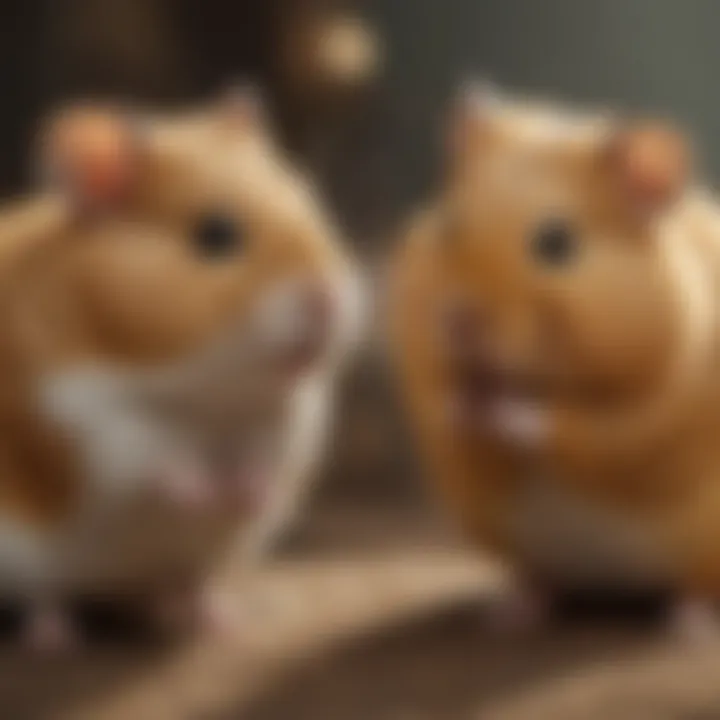Hamster Versus Gerbil: A Comprehensive Comparison


Intro
Navigating the world of small pets can be intriguing. Among the popular options are hamsters and gerbils. While both belong to the rodent order, their distinct characteristics set them apart. Examining their habitats, behaviors, dietary needs, and care requirements is crucial for anyone considering these pets.
Understanding these aspects can facilitate better decisions for potential pet owners. The aim is to create a comprehensive guide that reflects the individual needs of hamsters and gerbils. So, let's delve deeply into the relevant sections to enhance the understanding of these small creatures.
Care Tips
Proper care is fundamental to ensuring the health and happiness of hamsters and gerbils. Below are the essential routines and practices.
Daily Care Routines
Both hamsters and gerbils require a consistent care routine. Daily check-ins are vital.
- Feeding: Feed them fresh food each morning, ensuring sufficient components based on their specific needs.
- Interaction: Spend time with them regularly. They thrive on human interaction, which can improve their emotional health.
- Monitoring: Keep an eye on their behavior and health every day, which helps to identify any changes.
Cage Setup and Maintenance
Creating a comfortable habitat matters significantly.
- Size: Ensure the cage is appropriately sized. A bigger cage encourages more activity and reduces boredom.
- Bedding: Choose aspen shavings or paper bedding to absorb moisture and odor.
- Nesting Material: Provide nesting material to encourage natural behaviors.
Hygiene and Cleaning Practices
Cage cleanliness is non-negotiable.
- Spot Clean: Daily, remove food remnants or waste to maintain hygiene.
- Thorough Cleaning: Once a week, completely clean the cage, replacing bedding and disinfecting surfaces.
Seasonal Care Adjustments
Adjust care routines based on seasonal changes.
- Winter: Ensure the cage is sheltered from drafts, and consider a heat source.
- Summer: Maintain a stable cool environment to prevent overheating.
Both hamsters and gerbils operate naturally in environments that provide no extreme sufferring.
Behavioral Insights
Understanding the behavior of hamsters and gerbils is key. They exhibit certain habits that require careful observation to prevent issues.
Understanding Body Language
Reading body language helps identify mood and comfort levels.
- Ears pinned back signal fear.
- Fluffing fur often indicates excitement.
Common Behavioral Issues and Solutions
Some problems arise from lack of stimulation.
- Biting: If caused by fear or overcrowding, ensure a proper environment and handle safely.
- Hiding: They may conceal themselves when overwhelmed. Create secure spaces for retreat.
Positive Reinforcement Techniques
Using rewards is beneficial.
- Treats as rewards for good behavior promote bonding.
- Gentle verbal praise when appreciated creates a positive association.
Social Interaction Needs
Different rodent types have distinct social needs.
- Hamsters: Generally solitary; avoid sharing habitats.
- Gerbils: Tend to be social and can live in pairs or small groups.
Nutrition Guides
Nutrition directly connects to their overall well-being.
Essential Diet Components
Identifying suitable nutrients is crucial.
- Hamster Diet: Pellets formulated for hamsters, with some fruits and vegetables.
- Gerbil Diet: Commercial feed with seed mix for adequate protein intake.
Safe and Toxic Foods
Health concerns arise from improper feeding.
- Safe items: Carrots, cucumber, or apple (remove seeds)
- Toxic items: Chocolate, onion, and citrus fruits.
Supplements and Treats
Looking beyond basic diets can provide enrichment.
- In moderation, seeds can be given to offset standard diet repetitiveness.
- Vege Treats: Special treats like dried veggies support dietary variety.
Feeding Strategies for Different Species
Optimizing feeding practices maximizes health benefits.
- Timing: Same time each day helps set a routine.
- Portion Control: Control amounts to avoid obesity, especially in hamsters.


Wellness and Health
Health matters incredibly for hamsters and gerbils.
Routine Health Checkups
Regular vet visits ensure a baseline health measure.
- Annually, a checkup catches issues early.
Identifying Symptoms of Illness
Observing changes can help in swift action.
- Lethargy, changes in eating habits, or unusual noises can indicate health problems.
Preventative Care and Vaccinations
Preventing health issues rather than responding to them is ideal.
- Key vaccinations should be given as necessary. Consult a veterinarian's recommendations.
Mental and Emotional Well-being
Maintaining mental stimulation is essential.
- Challenges satisfy instincts and reduce anxiety. Offer both toys and open spaces.
Enriching Activities
Regular playtime prevents boredom and enthusiasm.
Toys and Playtime Ideas
Coming up with engaging activities isn't tough.
- Safe chew toys enhance mental activity.
- Tubes and adventurous paths bring excitement.
Training and Tricks
Simple training promotes bonding.
- Basic commands, like coming when called, reinforce connection.
Outdoor Activities and Interaction
Controlled outdoor exposure can provide engagement.
- Natural light and gentle exercise must be supervised.
DIY Projects for Mental Stimulation
Engaging tasks stimulate minds.
- Craft toys from household materials ensuring safety first.
Conclusively, the narrative around hamsters and gerbils supports animal welfare entirely. Acquaintance with their nuanced needs keeps pet owners informed and enthused, fostering enriched lives for both pets and owners alike. Learn more about small pets from resources abc attrg or visit larger communities like reddit.com and facebook.com.
Foreword to Small Pets
Small pets, particularly hamsters and gerbils, have become increasingly popular among animal lovers. Understanding these animals requires a look at their specific traits and living conditions. Discovering their unique characteristics can help you make informative decisions about pet ownership.
Owning a small pet offers numerous benefits. They can be ideal for families, individuals, or couples. Their compact size allows them to fit easily in varied living spaces. Importantly, small pets tend to require less maintenance than larger counterparts, which is attractive for busy owners.
While both hamsters and gerbils provide companionship, they exhibit distinct traits. The learning curve to properly care for them varies. Familiarizing yourself with these nuances is crucial for ensuring the animal’s health and well-being.
Significance of This Topic
As potential and current pet owners explore their options, understanding the differences between pets is essential. These insights are vital in assessing which animal will best suit your lifestyle. By diving into their characteristics, behaviors, and diet, you will become a well-informed owner.
Furthermore, detailed knowledge about these pets can lead to quality care. This includes choosing proper nutrition, housing, and interaction techniques, all contributing to a fulfilling life for your pet.
"Knowledge is power— It helps you make well-informed choices." Ultimately, elevating your understanding of hamsters and gerbils can enhance the bond you create with your future pet.
In summary, this article aims to equip both novice and experienced pet owners with thorough knowledge about hamsters and gerbils. It covers various integral aspects such as behavior patterns, housing solutions, and contextual information that contributes to a significant pet ownership experience.
Origins and Ancestry
Understanding the origins and ancestry of hamsters and gerbils provides valuable insights into their behaviors, habitats, and care requirements. This knowledge underlines the evolutionary adaptations each species has made, thus influencing how they thrive in captivity. Knowing the history of these small pets can guide prospective owners in deciding which animal fits best in their lives.
Hamster Lineage
Hamsters prosper from several distinct lineages. The best-known species is the Syrian hamster, native to the arid regions of Syria and surrounding areas. These hamsters adapted to survive in dry climates, where they burrow and store food for nourishment.
Other species, like the dwarf hamsters, originate from several locations. For instance, the Campbell's dwarf hamster is from Central Asia. Characteristically, hamsters possess unique physiological traits, relevant to their origins. Their cheek pouches are remarkable. These pouches allow them to transport and store food efficiently, showcasing real evolutionary advantages.
Additionally, these animals are solitary by nature, originating from environments where their survival required independence. In ancient habitats, competition was primarily for resources, meaning social interactions were often limited. Understanding this behavior can aid in creating effective captive environments.
Gerbil Lineage
In contrast, gerbils are a product of a unique lineage primarily traced to Mongolia. The Mongolian gerbil is the most acknowledged kind, which has adapted well to a small, arid region. They also dig elaborate tunnel systems, a natural behavior they continue in captivity.


Gerbils exhibit significant social behavior. They live in colonies in the wild, and this social structure plays an important role in their character. Gerbils are generally friendly creatures. Understanding their background reveals why they thrive better in pairs or groups compared to hamsters.
This distinct lineage defines many care practices and should guide anyone interested in adopting a gerbil.
Physical Characteristics
Understanding the physical characteristics of hamsters and gerbils is crucial in evaluating their management and care. Each species presents unique profiles that affect their housing, behavioral needs, and overall requirements as pets. The physical aspects directly relate to their suitability for potential owners, thus informing responsible pet ownership decisions and enhancing the human-animal bond.
Size and Weight
Hamsters generally vary in size based on species. For instance, the common dwarf hamster can weigh as little as 0.87 ounces, while the larger Syrian hamster can reach up to 5.5 ounces. Gerbils, in contrast, typically weigh between 2.5 to 4 ounces. Their varying sizes could influence not only cage dimensions but also handling techniques and social interactions. Larger animals, for instance, may require more spacious environments, while smaller ones can thrive in compact setups. It is also essential to consider how these size differences influence pet care, including feeding habits and exercise needs.
Coat Types and Colors
Both hamsters and gerbils boast diverse coat types and colors. Hamsters can have variations such as long-haired, short-haired, and even Rex fur, providing aesthetic appeal to potential pet owners. Common colors include golden, agouti, and spotted varieties. Gerbils often feature solid-colored coats like sandy and gray, as well as patterns involving stripes or spots. The color and coat texture might not significantly affect care but can enchant potential owners. Varieties can increase interest in each species, informing individual choices based upon looks in addition to temperament.
Lifespan
Lifespan serves as a vital factor when considering hamsters or gerbils as pets. Hamsters generally live 2 to 3 years, while gerbils often reach up to 3 to 5 years. This disparity influences decisions surrounding commitment levels. Many neophyte owners may underestimate the implications of these lifespans. The additional years of companionship in gerbils may be appealing for some. Adopting a pet entails understanding its long-term care requirements. Therefore, one should reflect on the lifetime care when considering the longevity of a chosen species.
Lifespan difference is essential in determining your commitment required for a pet. Selecting an animal with timing that aligns with your lifestyle is very important.
In sum, the scrutiny of physical characteristics in hamsters and gerbils is fundamental for owners and enthusiasts alike. These elements contribute significantly not only to the species boundaries but also inform daily care practices, fostering ideal living situations for both animals and their guardians.
Behavioral Traits
Behavioral traits of hamsters and gerbils play a crucial role in understanding these small pets. Different behavioral characteristics affect how they interact with their environments. Thus, it influences the general suitability of each pet for prospective owners.
Hamsters and gerbils have distinct social structures and activity preferences. Recognizing these traits helps in shaping their habitat and handling. Familiarity with these behaviors benfits not only animal welfare but also enhances the overall pet ownership experienc.
Social Interaction
Hamsters are often seen as solitary creatures. Each hamster usually prefers to dwell alone as adults. This isolation tendencies can lead to stress if they are placed with other hamsters. In contrast, some species of gerbils display social behavior. For instance, Mongolian gerbils thrive in pairs or small groups. They communicate through vocalizations and physical interactions. This difference impacts how owners should set up their habitats.
Interactions show different demands. Hamsters require more quiet, peaceful spaces. Gerbils, being more social, prefer enriched environments where they can engage with companions. When housing gerbils, maintaining a spacious setup will reduce monotony and encourage natural behaviors. The owner’s priorities must align with these requirements.
Activity Levels
Activity levels between hamsters and gerbils vary significantly. Hamsters tend to be more nocturnal. They initiate activity often at night, staying inactive during the day. This implies they may not encounter interaction confortably in a bustling household environment during the day.
On the other hand, gerbils are diurnal. They are likely engage more over daylight hours. This makes gerbils sometimes favored as pets in lively homes. Thus, understanding their activity helps tailor time for play and bonding sessions effectively. A wheel or tunnels can maintain their enthusiastic nature, especially for gerbils. Keeping the play consistent leads to happier and healthier pets, who engage in exercise more regularly.
Cognitive Abilities
Cognitive abilities can contribute to behavior expressions as well. Hamsters show problem-solving skills by learning to navigate mazes or find food sources efficiently. These activities not only keep them entertained but also mentally stimulated.
Gerbils, however, often showcase curiosity towards new objects and their environment. A knowledgeable pet owner would do well to provide stimulating tasks for both pets to avoid boredom. Keeping toys and hurdles within their enclosures fosters their learning. Understanding these cognitive aspects encourages more tailored caregiving.
In summary, recognizing behavioral traits such as social inclination, activity levels, and cognitive competencies allows an owner to create an environment that suit each pet's needs. Intelligent analysis is crucial towards promoting a nurturing surrounding for proper development.
Housing Requirements
Housing plays a critical role in the wellbeing of both hamsters and gerbils. Understanding the nuances of their habitats is essential for any potential owner. Proper housing minimizes stress, promotes health, and increases the lifespan of these small pets. Inadequate or incorrect housing can lead to behavioral issues and serious health concerns.
Cage Size and Type
When selecting a cage for your furry companion, size is an important factor. Hamsters require a minimum of 450 square inches of living space, while gerbils thrive in larger enclosures. The recommended cage size for gerbils is typically 2 feet by 1 foot, providing ample room for their natural exploratory behaviors. Proper ventilation is a must. Cages that allow for good air circulation greatly decrease the risk of respiratory problems.
Regarding types, plastic cages might be appealing for hamsters, as they're easy to clean and offers transparency. Wire cages with deep bases work best for gerbils due to their burrowing nature, allowing for substrates suitable for digging. For both hamsters and gerbils, choose escape-proof designs that increase safety.
Bedding and Substrate
Choosing the right bedding material can directly impact the comfort and health of your pet. For hamsters, aspen shavings or paper-based bedding are ideal. They absorb moisture well and reduce odors. Avoid cedar or pine shavings, which may harm their respiratory systems. Gerbils, on the other hand, favor a substrate that supports their burrowing instincts. Carefresh or aspen bedding is suitable as they can burrow comfortably.
Benefits of Good Bedding:
- Enhances comfort
- Reduces stress
- Minimizes odors and mess
- Provides natural digging opportunities for gerbils
Regular cleaning and changing of bedding is not only a hygiene issue but also assists in monitoring your pet’s health, ensuring that any changes in behavior or appearance are noticed early.
Environmental Enrichment
Both hamsters and gerbils need mental stimulation alongside physical space. Environmental enrichment enables pets to engage their natural instincts. For hamsters, toys like tunnels, exercise wheels, and chew items are important to prevent boredom and promote sensitive behaviors developing. Gerbils enjoy digging and burying; therefore, offering items like platforms and chewable cardboard can enhance their environment.
Proper enhancement allows your small pet to express its natural behaviors, leading to happier and healthier lives.
When considering the enrichment, mechanism matters. It is essential to rotate toys regularly to maintain novelty, keeping your pets active and engaged. Additionally, providing spaces to hide will ensure that they feel secure.
In summary, focusing on proper housing conditions such as cage size, material, bedding, and enrichment aids significantly in the healthy upbringing of hamsters and gerbils. Thought out care ensures that these small pets can thrive under human care.
Nutrition and Diet
Nutrition plays a vital role in the health and wellbeing of small pets, and both hamsters and gerbils have specific dietary requirements. Proper nutrition can influence not just their physical health, but also their behavior and longevity. Understanding the dietary needs is essential for pet owners who endeavor to provide the best care for their pets. Feeding them an appropriate diet can prevent several health issues and promote a happier, more active life.
Basic Dietary Needs
Hamsters and gerbils have different dietary preferences. Hamsters generally thrive on a mix of seeds, grains, fruits, and vegetables. Dry pellets designed for hamsters also meet their nutritional needs. Vitamin C is crucial since hamsters cannot synthesize it themselves. In contrast, gerbils are somewhat tougher. Their diets should include seeds, grains, and occasional treats such as fruits or vegetables but should avoid excess sugar. Gerbils rely on certain enzymes to digest fibers from grains and hay. Therefore, offering enough variety within a balanced diet is essential for both species.
Common Foods
For hamsters, popular food choices include:


- Commercial pellets specifically formulated for hamsters
- Fresh fruits like apples and bananas (in moderation)
- Vegetables such as carrots or broccoli
- Seeds including sunflower seeds and pumpkin seeds
In terms of gerbils, they often enjoy:
- Makow or other grain-based mixes designed for gerbils
- Barley, oats, and wheat as staple grains
- Occasional small pieces of fruits like cucumber or citrus (watch for sugar content)
- Fresh hay, as it's crucial for digestive health
Supplements and Treats
Supplementing the diet of either small pet can be helpful but should be approached cautiously. For hamsters, treats, such as dried fruits or yogurt drops, can be given sparingly to add variety without sugar overload. Gerbils enjoy occasional treats of nuts or seeds but should prioritize their primary diet. Keep in mind that treats should not make up more than 10% of their overall diet. Avoid foods high in phosphorous or carbohydrates. Both species can benefit from supplements that include vitamins and minerals, particularly those designed to enhance skin and fur health. Water availability is as critical as food; make sure to provide clean, fresh water at all times.
Proper nutrition plays a significant role in maintaining your hamster or gerbil's overall health. Understanding their unique dietary needs ensures a healthy and active pet life.
By focusing on their specific dietary requirements, pet owners can ensure that their pets have healthy and well-balanced meals, contributing directly to their overall health and longevity.
Health Considerations
In considering hamsters and gerbils as pets, health considerations are essential. Understanding these factors shapes an owner's experience and impacts the longevity and quality of life for the pets. Pet small animals invite unique health challenges and care routines.
They communicate discomfort more subtly than larger pets, so being diligent is crucial. Awareness of potential ailments and appropriate preventative measures keeps them safe and happy. An owner who comprehends these nuances will greatly enhance their pet's welfare.
Common Diseases
Both hamsters and gerbils have specific diseases that may affect their health.
Hamsters
- Wet Tail: A severe stomach condition leading to diarrhea. It can be life-threatening if untreated. Signs include lethargy and wet fur around the tail.
- Respiratory Infections: Common in poorly ventilated cages. Signs encompass labored breathing or nasal discharge.
- Skin Problems: Various skin conditions ranging from mites to allergies present as hair loss or scabs.
Gerbils
- Gerbil Male Calvicies: A condition where male gerbils intake too much protein resulting in hair loss.
- Tumors: More prone to developing tumors especially as they age.
- Diarrhea: Excessively wet waste can suggest issues with diet, requiring changes in nutrition.
Being familiar with these common diseases aids early detection and treatment, making for a healthier commitment to pet ownership.
Preventative Care
Preventing health care issues is highly vital. Here are some effective strategies for ongoing care:
- Routine Check-ups: Annual vet visits afford opportunities to discuss diet, habits, and screenings for diseases.
- Clean Environment: Regularly clean cages helps cease the spread of bacteria and keeps the living space fresh. This includes frequent washing of bedding and disinfecting cages.
- Quality Nutrition: Each type of pet thrives on proper nutrition. Special care in selection of quality pellets or mixes should be emphasized to preempt common issues like obesity.
Remember that prevention is typically much more cost-effective and compassionate than addressing severe illness later.
Healthy habitats enhance lifespan and quality of life. Educated, proactive approaches form the clearest path toward maintaining the well-being of hamsters and gerbils. As pet owners embrace their roles, attention in these areas pays off with happier, more robust small pets.
Training and Handling
Training and handling small pets is a key aspect that significantly contributes to the enjoyment of pet ownership. For both hamsters and gerbils, implementing proper strategies for training and establishing handling practices can lead to a more harmonious relationship between the pet and the owner. This section delves into the importance of these techniques, as well as specific methods tailored for both species.
Basic Training Techniques
Training small pets can seem challenging at first, but it helps enhance behavior and increase trust.
- Understanding Behavior: Taking the time to understand the natural behaviors of hamsters and gerbils is crucial. Each species has its own patterns of action; observing can lead to better training outcomes.
- Consistency is Key: When training, it is essential to be consistent with commands and signals. This helps pets learn faster and creates a predictable environment.
- Positive Reinforcement: Using treats can effectively reinforce desired behaviors. For example, a small piece of carrot for a hamster that learns to come when called builds a positive association.
- Short Sessions: Training should be broken into short sessions, as both hamsters and gerbils have limited attention spans. Keeping sessions under five minutes can greatly benefit productivity.
Regular training can provide intellectual stimulation for both species while reinforcing positive behavior patterns.
Handling and Bonding
Proper handling is necessary for establishing a bond with hamsters and gerbils. Here are some strategies for achieving this connection:
- Gentle Approach: Always approach your pet slowly and gently.
- Allow Exploration: Let the pet sniff your hands before picking them up. This offers familiarity.
Comparison Summary
Understanding the comparison summary is vital in assessing hamsters and gerbils as potential pets. This section encapsulates the key differences and similarities between these two small animals. Highlights include their behavioral traits, housing needs, dietary requirements, and overall care considerations. For informed decision-making, grasping these facets helps pet owners select the pet that aligns best with their lifestyle and expectations.
Key Differences
Hamsters and gerbils present distinct characteristics that can influence ownership. Some pivotal differences include:
- Social Habits: Hamsters tend to prefer solitary environments, whereas gerbils often thrive in pairs or groups. This impacts their housing arrangements and interaction levels with owners.
- Activity Cycles: Hamsters are mostly nocturnal while gerbils display more diurnal routines. This means hamsters may be more active at night, appealing for owners who enjoy late-night interaction.
- Lifespan Variance: On average, hamsters live about 2-3 years, whereas gerbils can span closer to 3-4 years. This difference will influence long-term planning for pet ownership.
- Housing Needs: Hamsters require more space considering their nesting behaviors; meanwhile, gerbils benefit from a larger area to burrow. Thus, evaluating space available is crucial.
”Knowing these key differences assists in making a more suitable pet choice for residents’ lifestyle.”
Best Fit for Owners
Determining the best fit between hamsters and gerbils often relies on individual preference and living conditions. Factors to consider include:
- Lifestyle Compatibility: Busy individuals might opt for gerbils due to their social nature. On the contrary, those valuing quiet single-pet companionship may prefer hamsters.
- Space Availability: Limited space can make a simplex hamsters housing more practical; larger environments comfortable accompany gerbils more effectively, fostering interaction.
- Pet Engagement Level: Engage actively requires; while helpless owners typically engage professionals for care for hamsters. Gerbil’s agility draws tolerant handling preferences.
In summary, evaluating personality traits, time commitment, and environment distinguish owners in selecting between hamsters and gerbils, shaping enjoyable companionship for years to come.
Culmination
In the realm of small pets, the choice between hamsters and gerbils extends beyond mere preference. This article emphasizes the significance of understanding the unique characteristics and requirements of each species. Making an informed decision is crucial for potential pet owners. It involves considering various factors such as temperament, habitat demands, and individual care needs before committing to either.
The differences highlighted throughout this analysis provide valuable insights that cater to both seasoned enthusiasts and those new to the world of small mammals.
Key points to ponder include:
- Behavior and Social Interaction: Hamsters are often solitary creatures, while gerbils thrive in communal settings.
- Housing and Environment: The layouts needed for their enclosures can differ significantly, impacting the level of enrichment and stimulation.
- Dietary Requirements: Nutritional needs must align specific dietary choices for either species.
"Understanding these elements not only enhances the experience of pet ownership but also ensures the well-being of the animal."
Moreover, the health considerations discussed can prove invaluable. It influences preventive measures owners can take against common ailments both species face. Developing a genuine bond with these pets involves more than just petting or playing; it encompasses safeguarding their physical and mental health as well.
When reflecting on the elements presented here, it is evident that a thoughtful choice can enhance the lives of both pet and owner. A hamster or a gerbil can become not just a pet but a part of the family. Ultimately, well-informed owners are better equipped to provide the kind of environment conducive to a joyful and fulfilling life for their small companions.















